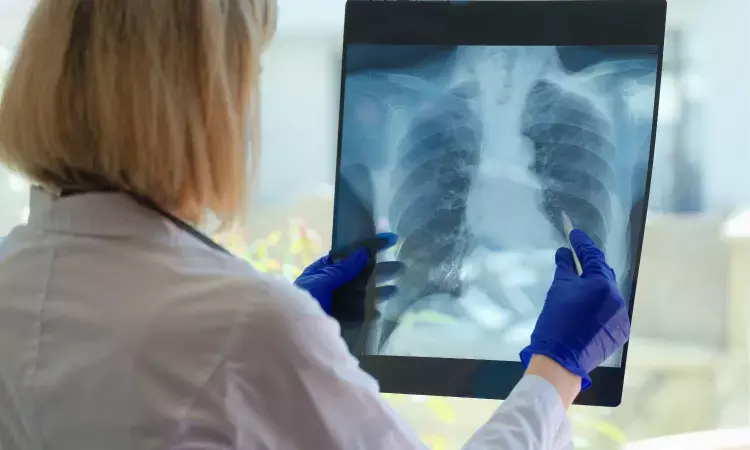- Home
- Medical news & Guidelines
- Anesthesiology
- Cardiology and CTVS
- Critical Care
- Dentistry
- Dermatology
- Diabetes and Endocrinology
- ENT
- Gastroenterology
- Medicine
- Nephrology
- Neurology
- Obstretics-Gynaecology
- Oncology
- Ophthalmology
- Orthopaedics
- Pediatrics-Neonatology
- Psychiatry
- Pulmonology
- Radiology
- Surgery
- Urology
- Laboratory Medicine
- Diet
- Nursing
- Paramedical
- Physiotherapy
- Health news
- Fact Check
- Bone Health Fact Check
- Brain Health Fact Check
- Cancer Related Fact Check
- Child Care Fact Check
- Dental and oral health fact check
- Diabetes and metabolic health fact check
- Diet and Nutrition Fact Check
- Eye and ENT Care Fact Check
- Fitness fact check
- Gut health fact check
- Heart health fact check
- Kidney health fact check
- Medical education fact check
- Men's health fact check
- Respiratory fact check
- Skin and hair care fact check
- Vaccine and Immunization fact check
- Women's health fact check
- AYUSH
- State News
- Andaman and Nicobar Islands
- Andhra Pradesh
- Arunachal Pradesh
- Assam
- Bihar
- Chandigarh
- Chattisgarh
- Dadra and Nagar Haveli
- Daman and Diu
- Delhi
- Goa
- Gujarat
- Haryana
- Himachal Pradesh
- Jammu & Kashmir
- Jharkhand
- Karnataka
- Kerala
- Ladakh
- Lakshadweep
- Madhya Pradesh
- Maharashtra
- Manipur
- Meghalaya
- Mizoram
- Nagaland
- Odisha
- Puducherry
- Punjab
- Rajasthan
- Sikkim
- Tamil Nadu
- Telangana
- Tripura
- Uttar Pradesh
- Uttrakhand
- West Bengal
- Medical Education
- Industry
Levels of specific eicosanoids associated with higher and lower odds of pulmonary hypertension

Pulmonary hypertension affects 1% of the global population. It is characterized by vascular remodelling and endothelial cell dysfunction, leading to right-sided heart failure. The aetiology is multifactorial, including left heart disease and lung disease as the common contributors. Inflammation in lung tissue, thought to be central to PH development, is caused by various cytokines and macrophages. Still, specific pro- and anti-inflammatory pathways leading to pulmonary vascular remodelling are unclear.
According to a study published in the European Respiratory Journal, Bioactive lipids are potential markers and contributors in the development of PH across the disease spectrum. Researchers in this study identified the association of specific linoleic acid, prostaglandin and other arachidonic acid derivatives with higher odds of PH. In comparison, lipokine and epoxide derivatives were associated with lower odds of PH.
Eicosanoids regulate systemic inflammation and exert vasoactive effects. There is an association between specific eicosanoid metabolites and PH, but more data needs to be available.
In this study, the team examined 482 patients with chronic dyspnea and performed a comprehensive profiling of 888 eicosanoids and related metabolites using directed, non-targeted mass spectrometry. They also examined associations with pulmonary hypertension and its subtypes, as well as physiological correlates such as transpulmonary metabolite gradients.
Key points of the summary are:
- There were 482 participants with a mean age of 56, and 62% were women.
- Two hundred participants had rest PH.
- Forty-eight eicosanoids and eicosanoid-related metabolites had an association with PH.
- Prostaglandin, linoleic acid and arachidonic acid derivatives were associated with higher odds of PH. In contrast, epoxide (8(9)-EpETE), α-linolenic acid (13(S)-HOTrE(γ)) and lipokine derivatives (12,13-DiHOME) were associated with lower odds of PH.
- Among PH-related eicosanoids, 14 showed differential transpulmonary metabolite gradients. This suggests that metabolites associated with lower odds of PH also displayed pulmonary artery uptake.
- In individuals with exercise PH, eicosanoid profiles were intermediate between no PH and rest PH, with six metabolites that differed between rest and exercise PH.
Concluding further, they said, our study findings highlight the role of specific eicosanoids, including linoleic acid and epoxide derivatives, as potential inflammatory regulators in Pulmonary Hypertension.
Our study identified 48 eicosanoid and eicosanoid-related metabolites associated with the rest of the PH they noted.
One of the study's strengths was its comprehensive inclusion of individuals across the spectrum of cardiopulmonary disease and its ability to assess pulmonary vascular traits using invasive hemodynamic measures carefully.
Reference:
McNeill et al. The association of eicosanoids and eicosanoid-related metabolites with pulmonary hypertension. The European Respiratory Journal, 62(4), 2300561. https://doi.org/10.1183/13993003.00561-2023
BDS, MDS in Periodontics and Implantology
Dr. Aditi Yadav is a BDS, MDS in Periodontics and Implantology. She has a clinical experience of 5 years as a laser dental surgeon. She also has a Diploma in clinical research and pharmacovigilance and is a Certified data scientist. She is currently working as a content developer in e-health services. Dr. Yadav has a keen interest in Medical Journalism and is actively involved in Medical Research writing.
Dr Kamal Kant Kohli-MBBS, DTCD- a chest specialist with more than 30 years of practice and a flair for writing clinical articles, Dr Kamal Kant Kohli joined Medical Dialogues as a Chief Editor of Medical News. Besides writing articles, as an editor, he proofreads and verifies all the medical content published on Medical Dialogues including those coming from journals, studies,medical conferences,guidelines etc. Email: drkohli@medicaldialogues.in. Contact no. 011-43720751


